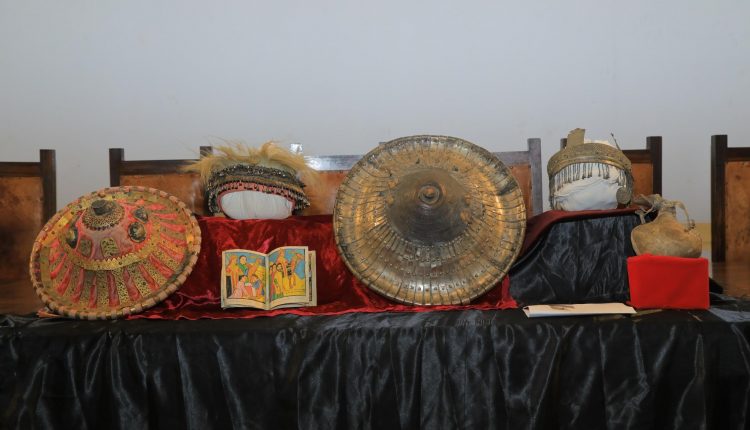Twelve Ethiopian Artefacts Handed Over, Enriching National Heritage
Addis Ababa, November 19, 2025 (FMC) — Twelve historic Ethiopian artefacts, taken from the country in the 1920s, were officially handed over to the Institute of Ethiopian Studies (IES) at Addis Ababa University on Tuesday, marking a landmark moment in heritage preservation and international cultural cooperation.
The handover, supported by the German Embassy, coincided with the university’s 75th Diamond Jubilee and reflects Ethiopia’s ongoing efforts to reclaim its cultural treasures from abroad.
The artefacts, returned by Professor Ramon Wyss and his niece Alice Weiss, were originally acquired by their grandfather, German envoy Fritz Weiss, during his tenure in Addis Ababa between 1921 and 1928.
The collection includes crowns, decorated shields, a sword, paintings, and gifts once bestowed by Regent Ras Tafari Mekonnen (later Emperor Haile Selassie), as well as items acquired by both Franz and Hedwig Weiss.
Tourism Minister Selamawit Kassa highlighted the historical and cultural significance of the items, describing them as a “unique glimpse into Ethiopian arts and craftsmanship of the 1920s.”
She noted that the handover complements previously returned artefacts, including those looted from Megiddo in 1868 and repatriated via AFROMET, and will enrich both the Institute’s collection and Ethiopia’s tourism offerings. “These restituted items will serve as valuable resources for research and education, and also become an important attraction for visitors,” she said.
The Minister thanked the Weiss family for preserving and returning the artefacts, calling their gesture a demonstration of deep affection and respect for Ethiopia. She added that the linked exhibition of 51 rare photographs, taken by Franz and Hedwig Weiss, will open tomorrow at the Goethe-Institut, offering fascinating insights into Ethiopian life in the 1920s.
She emphasized that the handover and exhibition form part of the 120-year celebration of Ethiopia-Germany diplomatic relations and stand as “a remarkable example of the enduring friendship between our two people and our two countries.”
For his part, German Embassy Chargé d’Affaires Dr. Ferdinand von Weyhe underscored that the artefacts were a private donation by the Weiss family, and the embassy’s role was purely supportive.
He praised the Weiss family for deciding to return these historical items to Ethiopia and highlighted the logistical challenges involved in their safe transport, commending Ethiopian customs, airport, and postal authorities for facilitating the process.
Dr. von Weyhe reflected on Fritz Weiss’s tenure in Ethiopia, noting his close personal ties with Empress Zewditu and Ras Tafari, and recalled the diplomat’s forced early retirement in 1934 due to his Jewish heritage. He also noted the Stolperstein in Berlin commemorating Fritz Weiss.
He described the upcoming Goethe-Institut exhibition of 51 photographs as a way to honor Fritz and Hedwig Weiss’s legacy, saying it will offer Ethiopians and tourists alike a unique view of the country in the 1920s.
He added that the handover reflects the embassy’s broader mission to foster collaboration between scholars, societies, and institutions beyond formal diplomatic channels.
Addis Ababa University President Samuel Kifle expressed gratitude to international partners, including Germany, Sweden, and Italy, who contributed to the repatriation effort.
He reaffirmed the university’s mission to preserve Ethiopia’s heritage and said the returned artefacts strengthen both the national collection and the university’s role as a center for research and education. “Ethiopia’s future depends on building on its strong past, and these artefacts are a tangible part of that legacy,” he said.
Professor Ramon Wyss shared the personal and historical significance of the handover, tracing its origins to his grandparents’ stay in Ethiopia nearly a century ago. He explained that the collection also includes digitized photographs, films, and memoirs documenting Ethiopian life, all of which will be freely accessible to researchers.
“With this handover, we aim to share the beauty of these artefacts with the public and contribute to preserving Ethiopia’s rich heritage and history,” he said, acknowledging the crucial role of SOFIS members and the German Embassy in facilitating the process.
IES Director Yohannes Adigeh reflected on the long-term efforts to collect and preserve Ethiopian heritage worldwide. He highlighted the role of the Centre for Museum Studies in managing artefacts representing diverse ethno-linguistic communities and emphasized the handover as part of the Institute’s broader mission to foster unity, diversity, and national solidarity.
The handover was formalized through the signing of an official agreement, legally documenting the process. The artefacts will be featured in an exhibition at the Goethe-Institut starting tomorrow, allowing the public to experience Ethiopian life in the 1920s through both artefacts and photographs.

